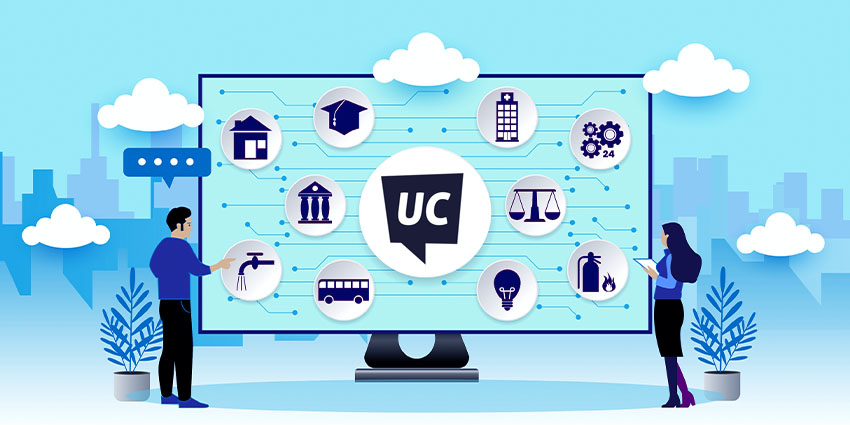Unified Communications (UC) technology has become increasingly popular in recent years, providing a platform for seamless and efficient communication and collaboration across multiple channels. In the public sector industry, where effective communication and collaboration are critical to delivering high-quality services and engaging citizens, UC technology is becoming an indispensable tool. In this article, we will explore the state of unified communications technology in the public sector industry, including recent trends, challenges, and opportunities.
Recent Trends in Unified Communications Technology in the Public Sector
The use of UC technology in the public sector has been growing rapidly in recent years, as public sector agencies seek to improve communication and collaboration while reducing costs. Some of the recent trends in unified communications technology in the public sector industry include:
- Increased adoption of cloud-based UC solutions: With the rise of cloud technology, more public sector agencies are moving towards cloud-based UC solutions. Cloud-based solutions provide greater flexibility and scalability, enabling public sector agencies to scale up or down as needed and pay only for the services they use.
- Integration with other technologies: UC technology is increasingly being integrated with other technologies, such as artificial intelligence (AI), to provide more efficient and effective communication and collaboration.
- Mobile-first approach: With the increase in remote work and mobile devices, public sector agencies are adopting a mobile-first approach to UC technology, providing employees with access to communication and collaboration tools from their mobile devices.
- Emphasis on security: As with all technology in the public sector, security is a top priority. UC technology providers are placing a greater emphasis on security, providing encryption, authentication, and other security features to protect sensitive data.
Challenges of Unified Communications Technology in the Public Sector
While UC technology provides many benefits to public sector agencies, there are also challenges that must be addressed. Some of the main challenges of UC technology in the public sector include:
- Legacy Systems: Many public sector agencies have outdated legacy systems that are not compatible with modern UC technology. Upgrading or replacing these systems can be costly and time-consuming.
- Budget Constraints: Public sector agencies often face budget constraints, limiting their ability to invest in new technology solutions.
- Resistance to Change: Implementing new technology solutions can be met with resistance from employees who are used to working with traditional systems.
- Security Concerns: With the increased emphasis on security, there is a risk that security concerns may outweigh the benefits of UC technology in the public sector.
Opportunities for Unified Communications Technology in the Public Sector
Despite the challenges, there are many opportunities for UC technology in the public sector industry. Some of the main opportunities include:
- Improved Communication and Collaboration: UC technology provides a platform for seamless communication and collaboration, enabling public sector agencies to work more efficiently and effectively.
- Enhanced Citizen Engagement: UC technology can improve citizen engagement by providing better and more accessible communication channels, resulting in better engagement and satisfaction.
- Cost Savings: UC technology can reduce the costs associated with traditional communication methods, resulting in cost savings and increased efficiency.
- Increased Efficiency and Productivity: UC technology can enable public sector agencies to streamline their communication processes and automate repetitive tasks, freeing up time for employees to focus on more important tasks.
- Improved Service Delivery: UC technology can improve service delivery by enabling real-time collaboration and sharing of information, resulting in faster response times and improved outcomes for citizens.
Future Outlook for Unified Communications Technology in the Public Sector
The future outlook for UC technology in the public sector industry is positive. As public sector agencies continue to prioritize effective communication and collaboration, UC technology will become increasingly important. The integration of UC technology with other technologies, such as AI and the Internet of Things (IoT), will provide even greater opportunities for public sector agencies to improve service delivery and citizen engagement.
Furthermore, the increased adoption of cloud-based solutions and mobile-first approaches will enable public sector employees to work from anywhere, at any time, improving efficiency and productivity. In addition, as security concerns continue to be a top priority, UC technology providers will continue to enhance security features, providing public sector agencies with the necessary tools to protect sensitive data.
Another trend that is likely to shape the future of UC technology in the public sector is the rise of remote work. The COVID-19 pandemic has accelerated the adoption of remote work in the public sector industry, with many public sector employees now working from home. UC technology has played a key role in enabling remote work, providing employees with the necessary tools to communicate and collaborate effectively from anywhere.
As remote work becomes more common in the public sector industry, public sector agencies will need to ensure that their UC technology solutions are able to support remote work effectively. This may require a shift towards more cloud-based solutions and a mobile-first approach, as well as an emphasis on security and remote access.
In addition, the rise of remote work is likely to lead to an increased focus on employee well-being and work-life balance. Public sector agencies will need to ensure that their UC technology solutions are able to support flexible working arrangements and provide employees with the necessary tools to maintain a healthy work-life balance.
Conclusion
Unified Communications technology is becoming increasingly important in the public sector industry, providing a platform for seamless and efficient communication and collaboration across multiple channels. While there are challenges to implementing UC technology in the public sector, including legacy systems, budget constraints, resistance to change, and security concerns, the benefits are significant, including improved communication and collaboration, enhanced citizen engagement, cost savings, increased efficiency and productivity, and improved service delivery.
Looking to the future, the adoption of cloud-based solutions, mobile-first approaches, and integration with other technologies, such as AI and IoT, will provide even greater opportunities for public sector agencies to improve service delivery and citizen engagement. As remote work continues to grow in the public sector industry, UC technology will become even more important, providing employees with the necessary tools to communicate and collaborate effectively from anywhere, while maintaining a healthy work-life balance.







